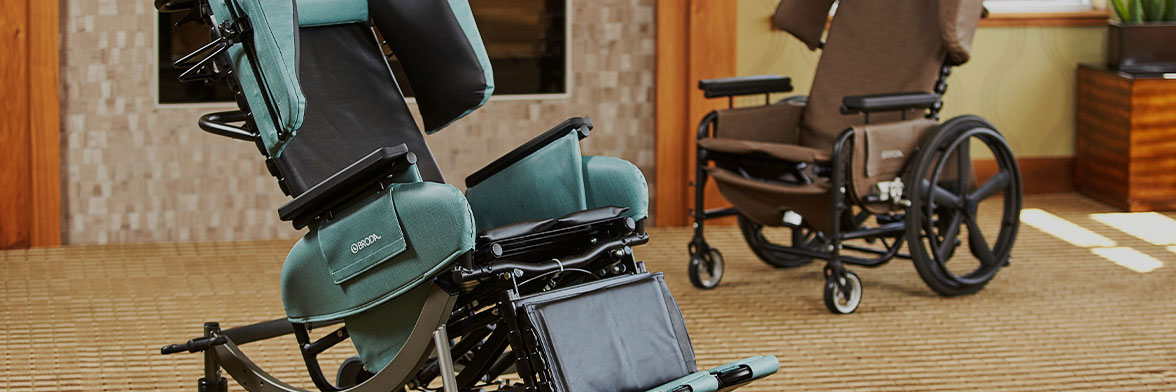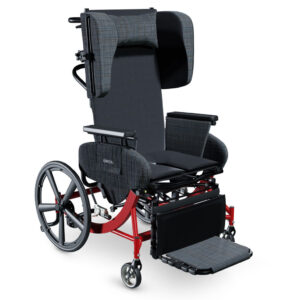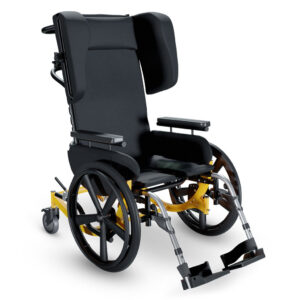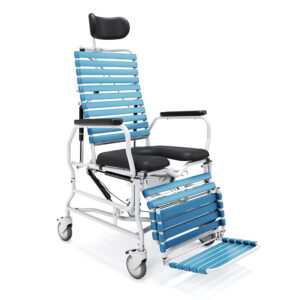Proper Positioning & Pressure Injuries
Pressure injuries (also known as pressure ulcers or pressure sores) cause over 60,000 deaths per year.1 On the positive side, proper positioning can prevent and treat pressure injuries. Conversely, incorrect positioning can lead to inordinate amounts of pressure being placed on bony prominences in the body, which contributes to skin breakdown and pressure injuries.2
Our Recommendations
Comfort is Essential to Wound Care
Correct postural alignment and equal weight distribution are the main factors in a person’s risk for developing pressure wounds. At Broda, our goal is to make every person comfortable, with reduced risk for pressure injuries. That’s why we created our one-of-a-kind Comfort Tension Seating® system. Unlike conventional sling-style wheelchairs, Comfort Tension Seating® is made up of individual straps that mold to the user’s body, creating a supportive seating surface. This unique seating system relieves pressure better than a typical cushion by suspending the user’s weight evenly across multiple points, rather than a solid seating surface. As well as preventing pressure injuries, Comfort Tension Seating® also increases sitting tolerance, allowing the user to spend longer periods of time out of bed.
Choosing the Right Cushion for Pressure Redistribution
In addition to positioning features, cushions play a key role in preventing pressure ulcers. While there are many cushions on the market, consider those made specifically for treating and preventing pressure wounds. Broda positioning wheelchairs with Comfort Tension Seating® and the standard Broda cushion package significantly reduce pressure on their own. On the other hand, our rehab wheelchairs feature a solid seat pan and need a cushion. In this case, we recommend cushions from the Matrx® Seating Series by Motion Concepts. The Libra cushion is recommended for those with the highest risk of pressure injuries. Similarly, the PSP cushion provides skin protection with no maintenance necessary.
Avoiding Pressure & Shear During ADLs
A person is more prone to pressure injuries if they are dependent on a caregiver for their activities of daily living (ADLs).3 Caregivers can take preventative measures during ADLs to avoid unnecessary pressure and shear. Broda designs our wheelchairs to reduce the strain placed on the skin during transfers and ADLs such as dressing, toileting, and bathing. During these ADLs, Broda wheelchairs give the caregiver an advantage. Our positioning wheelchairs, pedal wheelchairs, and shower commode chairs feature removable arm, leg, and shoulder supports to make transfers smooth. In turn, this reduces the strain on the patient’s skin.
Cost-Saving Preventative Measures
Surprisingly, pressure injuries and ulcers cost healthcare providers and patients over $11.6 Billion USD per year.1 This is at an average cost of $10,700 USD per pressure injury, with some cases having multiple injuries.1 In contrast, purchasing a quality, customizable positioning wheelchair costs a small fraction of that amount. On top of the monetary costs, 84% of pressure injury patients report being in pain, even at rest.4 Looking at the return on investment in cost savings and comfort, a Broda wheelchair is the clear choice.
The Best Wheelchairs for Reducing Pressure Injuries
In summary, Broda wheelchairs are an excellent choice for anyone worried about developing a pressure injury. Our wheelchairs are comfortable, adjustable, and compatible with a variety of cushions to help you stay out of bed, be mobile, and enjoy a high quality of life.
References
- Agency for Healthcare Research and Quality. (2014). Are we ready for this change? AHRQ. Retrieved March 10, 2022, from https://www.ahrq.gov/patient-safety/settings/hospital/resource/pressureulcer/tool/pu1.html
- AlAboud, AM, Manna, B. (2021, July 1) Wound Pressure Injury Management. StatPearls [Internet]. StatPearls Publishing; 2021 Jan-. Retrieved October 20, 2021, from https://www.ncbi.nlm.nih.gov/books/NBK532897/
- Akbuğa,Gökçen & Mucuk, Salime. (2015). The Evaluation of Daily Living Activities, Pressure Sores and Risk Factors. Rehabilitation nursing: the official journal of the Association of Rehabilitation Nurses. 40. 10.1002/rnj.145.
- Yeroushalmi, B. (2019, March 13). Exploring the social and psychological effects of pressure ulcers. California Nursing Home Abuse Lawyer Blog. Retrieved March 10, 2022, from https://www.californianursinghomeabuselawyer-blog.com/exploring-the-social-and-psychological-effects-of-pressure-ulcers/



